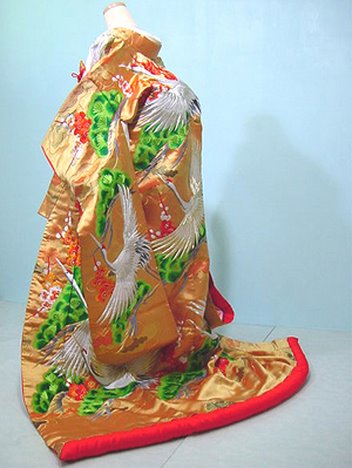Difference between revisions of "Uchikake"
(New page: Uchikake is an elaborate robe that is worn by the bride at a wedding or at a stage performance. It is often heavily brocaded and embroidered with motifs symbolizing luck and joy, such as f...) |
|||
| (2 intermediate revisions by the same user not shown) | |||
| Line 1: | Line 1: | ||
| − | Uchikake is an elaborate robe that is worn by the bride at a wedding or at a stage performance. It is often heavily brocaded and embroidered with motifs symbolizing luck and joy, such as flowers, cranes, pines, flower carts or nature motifs. The uchikake of the bridal costume is either white or very colorful with red often as the | + | [[Image:Uchikake 07-custom.jpeg|thumb]] |
| − | + | Uchikake is an elaborate robe that is worn by the bride at a wedding or at a stage performance. It is often heavily brocaded and embroidered with motifs symbolizing luck and joy, such as flowers, cranes, pines, flower carts or nature motifs. The uchikake of the bridal costume is either white or very colorful with red often as the base color. The white uchikake is worn at the wedding ceremony, while the coloured uchikake is worn afterwards at the reception. Underneath it you wear a white [[kimono]], called kakeshita, with an [[obi]] tied around it. You never tie obi around the uchikake. It is supposed to trail along the floor and this also why it is heavy padded along the hem. Red is the most popular color for kimono, but you can see many different colors, from dark blue to black and green. The Uchikake is very expensive, and is often handed down in the family or made into futons. | |
| − | |||
| − | |||
It has long sleeves to signify that the woman is yet unmarried. After the wedding, her sleeves will be shorter; about half the length of the furisode, that is characterized by it's long swinging sleeves. The reason for the change is that the long sleeves were unpractical for the married woman, when cleaning, doing the dishes and other house work. | It has long sleeves to signify that the woman is yet unmarried. After the wedding, her sleeves will be shorter; about half the length of the furisode, that is characterized by it's long swinging sleeves. The reason for the change is that the long sleeves were unpractical for the married woman, when cleaning, doing the dishes and other house work. | ||
| Line 10: | Line 8: | ||
*[http://www.bookmice.net/darkchilde/japan/uchikim.html Blog with photos] | *[http://www.bookmice.net/darkchilde/japan/uchikim.html Blog with photos] | ||
*[http://www.worcesterart.org/Exhibitions/1984.29.html Edo period example] | *[http://www.worcesterart.org/Exhibitions/1984.29.html Edo period example] | ||
| + | [[Category:Japanese Garb]] [[Category:Garb]] [[Category:How To]] | ||
Latest revision as of 07:24, 5 January 2009
Uchikake is an elaborate robe that is worn by the bride at a wedding or at a stage performance. It is often heavily brocaded and embroidered with motifs symbolizing luck and joy, such as flowers, cranes, pines, flower carts or nature motifs. The uchikake of the bridal costume is either white or very colorful with red often as the base color. The white uchikake is worn at the wedding ceremony, while the coloured uchikake is worn afterwards at the reception. Underneath it you wear a white kimono, called kakeshita, with an obi tied around it. You never tie obi around the uchikake. It is supposed to trail along the floor and this also why it is heavy padded along the hem. Red is the most popular color for kimono, but you can see many different colors, from dark blue to black and green. The Uchikake is very expensive, and is often handed down in the family or made into futons.
It has long sleeves to signify that the woman is yet unmarried. After the wedding, her sleeves will be shorter; about half the length of the furisode, that is characterized by it's long swinging sleeves. The reason for the change is that the long sleeves were unpractical for the married woman, when cleaning, doing the dishes and other house work.
